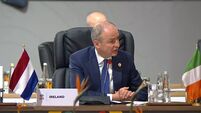Records place O’Reilly miles from alibi
Data from phone masts show that the mobile phone owned by Derek Quearney, who worked with O’Reilly at the Viacom outdoor advertising firm, was used in Dublin city on the morning of the murder, at a time when records place the mobile phone owned by the accused near the O’Reilly home in north Co Dublin.
O’Reilly, aged 35, is on trial at the Central Criminal Court for the murder of his wife, Rachel, aged 30, at the family home at Lambay View, Baldarragh, The Naul, Co Dublin, on October 4, 2004. He denies the charge.
Giving evidence to the trial, Oliver Farrell of the mobile network engineering consultancy, Vilicom, said data from mobile phone calls made to and from Mr Quearney’s phone on the morning of October 4, were in line with what O’Reilly said Mr Quearney did on the day.
The data, extracted from mobile phone masts, places Mr Quearney and O’Reilly at the Jackie Skelly gym at 7.30am and at work at the Vicacom offices at Bluebell Industrial Estate in Dublin between 8am and 9am, which matches O’Reilly’s statement.
Further records track Mr Quearney moving towards the Broadstone bus depot between 9am and 9.25am and being at the depot up to 11.16am before moving back towards the Bluebell Industrial Estate.
O’Reilly, however, told gardaí he accompanied Mr Quearney to Broadstone, although they travelled in separate cars so that each could claim mileage.
Oliver Farrell testified on Monday that O’Reilly’s mobile phone was used at Baldarragh at 9.25am and 9.52am. He gave further evidence yesterday that the earliest he could place O’Reilly’s phone at Broadstone was at 10.38am — over an hour after Mr Quearney.
One piece of data failed to follow the pattern of Mr Quearney’s calls. It showed a phone call at 11am, when O’Reilly was at Broadstone, used a signal from a mast at Harcourt Street in the city centre, rather than a mast close to Broadstone.
However, Mr Farrell said this was “unusual but it’s feasible”. “That is due to the height of that transmitter and the northerly direction of the antennae,” he said.
Counsel for the defence, Patrick Gageby SC, asked if this did not show that data from phone masts was unreliable in indicating the location of a person using a phone receiving a signal from that mast. Mr Farrell said masts were designed to serve the demands of users in their vicinity and stressed again the unusual height of the Harcourt Street mast.
“But you may well have a reach which is well bigger and well further than your theoretical model,” Mr Gageby said. “That’s correct,” Mr Farrell replied.
Two other experts ruled out the possibility that a mast close to the O’Reilly family home could have provided a signal to a mobile phone as far away as Broadstone. “It’s impossible,” said Karim Benabdallah, a consultant working for the O2 network.
Another consultant engineer, Eddie Gleeson, said: “I would see that as extremely unlikely.”












